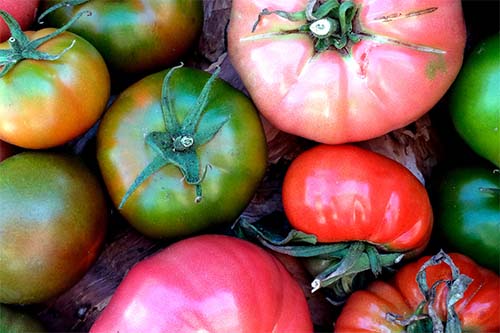Tomatoes hit their stride in August in the northern hemisphere. Capable of being used in everything from soup to dessert, here’s a deeper look at one of the world’s most versatile products.
If you’ve ever spent even a little time at the farmers' market, you’ll know that August is all about tomatoes: cherry tomatoes become little bursts of tomato candy, heirloom varieties are worthy of meals unto themselves, beefsteaks invite entire sandwiches to be built around them and plum varieties beg to be taken home for jarring or canning.
While tomatoes fare better than most produce when it comes to preserving them for the colder months, now is the time to celebrate fresh tomatoes while they are in their absolute prime. To that end, here’s a primer on the what, where and how of tomatoes, late summer’s culinary superstars.
What are Tomatoes?
Tomatoes are highly recognizable in various types, of course, but did you know that tomatoes are actually a fruit? What’s more, tomatoes technically qualify as a berry, biologically speaking. Tomatoes are part of the reproductive mechanism for vining plants known as Solanum lycopersicum. The term Solanum belongs to all nightshades — biological relatives of tomatoes that also include eggplants and peppers, among others. (Of importance to chefs, nightshades are a somewhat common food allergy, so it’s an important one to be aware of, especially if tomatoes are frequently used in your stocks and sauces.) Lycopersicum relates to tomatoes’ red coloring, as lycopene is an organic compound that has commonality among several red and pink fruits and vegetables. While tomatoes are known (and named) for their redness, tomatoes come in a variety of colors including yellow, orange, green and even purple.
Related reading: What is the Difference Between Fruits and Vegetables?
History of Tomatoes
While tomatoes are commonly associated with Italian and other Mediterranean cuisines, they are actually only indigenous to Central and South America. Due to exploration and colonialism, tomatoes made their way to Europe as late as the 1500s. Because they are relatively easy to cultivate in a variety of climates, and can be successfully grown in greenhouses, tomatoes now appear in just about every cuisine around the world.
Common Types of Tomatoes
Tomatoes come in hundreds of varieties that can vary regionally, and buying locally during tomato season is the best way to get to know the most important ones in your area. Broadly speaking, however, the most common types of tomatoes are:
- Cherry: small, spherical tomatoes that are sweet and juicy, commonly used in salads or raw preparations. Cherry tomatoes come in a variety of colors beyond red.
- Grape: small tomatoes similar to cherry, with a slightly more oblong shape resembling grapes.
- Roma/Plum: also known as Italian tomatoes, roma tomatoes are fleshy with few seeds and low moisture, making them excellent for canning or drying, or for making sauces.
- Campari: grown hydroponically and vine-ripened, Campari tomatoes are known for their bright red color and sweet taste. Campari tomatoes are also considered “cocktail” tomatoes — larger than cherry or grape varieties but smaller than plum.
- San Marzano: the most famous tomato used in Italian cuisine, San Marzano tomatoes are a type of plum tomato with hearty flesh and few seeds. San Marzano tomatoes are largely considered the best canned tomatoes for cooking.
- Beefsteak: known for their dramatic size, beefsteak tomatoes are one of the largest varieties of tomatoes. Slightly sweet and moderately juicy, beefsteaks are typically sliced for sandwiches, or can also be used for preserving and sauces.
Related reading: The Mother Sauces and Their Offspring

What are Heirloom Tomatoes?
Unlike the same-sized, bright red tomatoes commonly stocked in grocery stores, heirloom tomatoes, which often have unusual colors and shapes, are historical tomato varieties that have been allowed to continually pollinate naturally.
Many non-heirloom varieties, such as cherry tomatoes and roma tomatoes, are typically hybrid varieties that have been cultivated and bred for specific qualities. Those qualities often include consistent ripening characteristics and disease resistance, which produce tomatoes of uniform colors and shapes but not necessarily exceptional or unique flavor.
Heirloom tomatoes, on the other hand, can run the gamut of tomato colors and shapes. Their unique qualities are thanks to the fact that heirloom tomatoes are not hybrid crops bred for a specific purpose, unlike other tomatoes. Because of this, heirloom tomatoes also tend to have a shorter shelf life than common varieties, but are more flavorful.
Because of their dramatic appearance, heirloom tomatoes make for terrific salads or first courses where they are featured as the star of the dish.
Ripening and Storing Tomatoes
Repeat after me: do not refrigerate tomatoes. Whether ripening or storing, the refrigerator is the enemy of happy tomatoes, which have cellular properties that react to the cold. Refrigerating tomatoes causes their cell membranes to break down, rendering them mealy.
In terms of ripening, while certain varieties of tomatoes are intentionally ripened on the vine, it is possible for tomatoes to continue to ripen after being picked. Placing tomatoes in a brown paper bag kept out of direct sunlight can speed the ripening process along. Already ripe tomatoes should be stored at room temperature out of direct heat. Resist the urge to rinse or wash your tomatoes until it’s time to eat them, as excess moisture can also affect their texture during storage.
Culinary Applications of Tomatoes
Because tomatoes are a fruit with savory characteristics, they really can be put anywhere on the menu: in a classic Caprese salad, Southern-style tomato sandwiches, classic sauces and even tomato sorbet. They can function in classic comfort foods like tomato soup or pizza, as they can in elevated preparations. (See below.) Even unripe tomatoes have their moment as fried green tomatoes.
Check out some of our favorite recipes featuring tomatoes:






